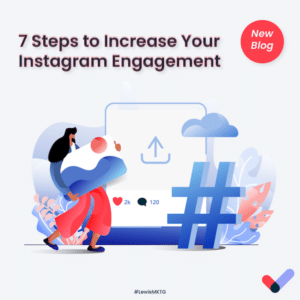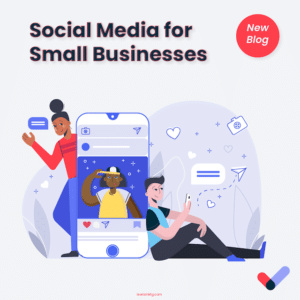Introduction
Social Media may not be the first thing on your mind if you wear multiple hats in your company. Business operations that keep the lights on are always the number one priority—leaving little to no time for social media marketing.
Studies have shown that social media users regularly interact with companies via social media. If a customer can’t get through to tech support, they’ll voice their opinion online.
Social media gets a faster response than waiting in a phone queue for the next available representative when you are frustrated with a company.
You could kill two birds with one stone if you created a couple of social media platforms. This article will provide several suggestions on how to leverage social media for your small business.
1. Find Your People
Social Media may not be the first thing on your mind if you wear multiple hats in your company. Business operations that keep the lights on are always the number one priority—leaving little to no time for social media marketing.
Studies have shown that social media users regularly interact with companies via social media. If a customer can’t get through to tech support, they’ll voice their opinion online.
Social media gets a faster response than waiting in a phone queue for the next available representative when you are frustrated with a company.
You could kill two birds with one stone if you created a couple of social media platforms. This article will provide several suggestions on how to leverage social media for your small business.
2. Identify your Customer Journey
For most companies, the ideal customer journey is to reach the intended goal of sales, leads, or driving engagement in one or two steps. Unfortunately, most companies’ customer base is more complex.
Studies have shown that 92 percent of consumers abandon a company’s website without purchasing on their initial visit. Although this seems problematic, this valuable data can be insightful for identifying your customer’s behaviors.
The ideal customer you created for your online persona can now help you build out a Customer Journey. You know this person’s likes and dislikes, which means your website should be able to keep their attention and reach the desired goal.
Suppose you don’t see the results you wanted. In that case, reporting platforms like google analytics can help define the steps in the funnel that your customer goes through.
3. Track Your People

Having difficulty getting the results you want, likely, you don’t have enough data. Tracking and measuring the effectiveness of your social media content is critical to building brand equity.
Without data, you’re just throwing things out, hoping that something will stick. Google Analytics is a free tool that can track every page on your website. It also allows you to create custom metrics for each social media campaign you run.
Once you create a Google Analytics account, Google provides you with step-by-step instructions on adding tracking code to your website.
This information provides insight into how successful a sales promotion is going or if your readership has increased for a particular blog post.
The more you can track and measure, the more you know about who is interacting with your brand. Tracking also gives an insight into which areas of your business are working well and which areas need improvement.
Over time this information can be used if you want to leverage your brand for B2B marketing.
4. Plan Ahead
Now that you have the hard stuff out of the way, it’s time to create content. I’m also glad you’re still reading; this shows your serious about getting this social media thing right for your business.
Creating content may seem like a tall task if you don’t have a creative background, or so you may think. Making your post look pretty is just half the battle. As an industry expert, you have a plethora of knowledge to offer your followers.
Your online persona is an extension of your brand; you want the content to match that. If your company’s ideal customer is a millennial in health and wellness, your content should show that.
The rule of thumb before you start posting on social media is to have a plan.
Create a social media calendar that is two weeks ahead. If you wear multiple hats in your organization, set aside a couple of hours one day of the week to come up with your content. Once you’ve knocked out the schedule, you can go back today to day operational tasks.
Everyone involved with the social media portion of the business must know what’s on the content calendar.
There will be times when social media will take the back seat to more pressing issues, and that’s okay. The goal is to implement a system that will make your job easier and still build your digital presence.
5. Optimize
material will be a hit, and that’s fine. The goal is to optimize through testing your campaign strategies to see what works for your business.
Set a timeframe that you want to test your campaign strategy, then compare and contrast the results to see which posts are performing the best.
If you decide to run paid ads, you can set up the A/B Test. Which will give you insight on which one of your ads or sponsored posts performed the best?
Pro Tip:
- Create 2 Ads sets for your A/B Test, run the campaign for a month and see which ad does the best.
- Replace the underperforming ad with one from the second set of ads and rerun the campaign.
- Once you have the result from that campaign, replace the underperforming ad with the last image and rerun the campaign for one more month.
Conclusion
As a small business, social media is not at the top of the priority list. That doesn’t mean it can’t be an extension of your brand that increases your awareness in the marketplace.
Social media shouldn’t be something that you need to stress over; it can be one of the areas of your personable business.
Digital Marketing will continue to grow, and your business doesn’t want to be last to the party. So, find your people, identify your customer journey, track your people, plan, and optimize.
At this point, you have nothing to lose by creating a couple of social media accounts for your business. If social media still isn’t for you consider hiring a professional within your budget to manage your pages.
Lewis Marketing offers an array of social media package for companies of all sizes.








